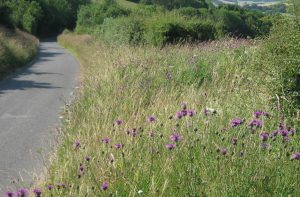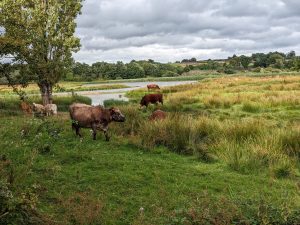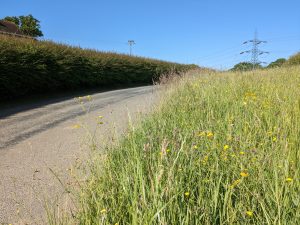What exactly is ‘Other Neutral Grassland’ and how should we make the best of it?- By Richard Gowing
Biodiversity Net Gain (BNG) is a system in England to ensure that habitat for wildlife is in a better state than it was before development. Developers must put back habitats they remove and achieve a 10% uplift on the pre-impact baseline. The ‘balance sheet’ of habitat losses and gains is assessed using Natural England’s BNG metric (Natural England, 2023).
The Natural England metric gives developers a relatively high score per hectare for creating a type of grassland habitat which ecologists have jargonistically called ‘Other Neutral Grassland’ (ONG). ONG is a relatively new kid on the habitat surveyor block, introduced by the UK Habitat classification (UKHab, 2023; see Box 1). It is basically a commonplace type of grassland that we find all over the country. Think road verges, railway linesides and unkempt pastures, throughout the land.
Its ‘otherness’ is because it represents a group of neutral grassland types which don’t quite make the cut as priority meadow types. They support few rare plant species (e.g. Rodwell, 1992), and they have only moderate plant diversity (c. 9 – 15 species per square metre). Yet they are also not the most impoverished grasslands. That accolade is reserved for what the UKHab system calls ‘modified grassland’; often a monoculture of perennial rye-grass and white clover. In botanical terms, ONG represents a halfway house between the very good and the poor. A bucket of mediocre grassy places if you like.
|
BOX 1: UKHAB CODES FOR THE ONG FAMILY OF GRASSLANDS Level 4
Level 5
|
Criticism of ONG
A key criticism of the BNG metric is that it perversely incentivises such mediocrity, by awarding more units per hectare for ONG than for ‘better’ grassland types. This is because ONG is less difficult to create in the short-term than the priority hay meadow types, thus the metric applies less onerous risk multipliers. Broadly speaking, developers need less land to deliver an uplift in unit score by creating an offset containing ONG over a priority grassland type. In this way, the metric might perversely encourage the mediocre over the rare/diverse (Glenister, 2022).
Another criticism of the metric is that the condition assessment tool for ONG is claimed to be a relatively poor indicator of what is good for biodiversity at large. It gives a higher condition score to grasslands with more plant species but down scores grassland with too many tall ruderal herbs and excessive bare earth. However, we know that both attributes can be excellent for invertebrates (Oxford Biodiversity Network, 2023). Damp areas neither score positively or negatively, but these can be biodiverse hotspots for birds, amphibians, and other species. Mosaics of different types of ONG don’t sway the score and yet we know that mosaics promote diversity in grassland wildlife (Peterken, 2013).
There are two further reasons why ONG is likely to become a target for habitat creation. Firstly, ecologists need to be realistic about the viability of creating priority grassland types in many places. Much of the UK is awash with nutrients originating from transport and industrial emissions and farming practices. We know that species-rich plant communities rarely occur where phosphates and nitrates exceed certain concentrations in soil and water. However, the sheer effort required to remove these nutrients may be simply too expensive or impractical (e.g. stripping or inverting topsoil, sacrificial cropping etc.). Secondly, the traditional hay meadow adorns many a picture book and is always something to cherish, behold and protect. However, the management practices that gave us our species-rich hay meadows in the past are not viable in many modern situations. For example, low intensity grazing with hardy cattle doesn’t necessarily work in areas of heavy human use.
What is apparent is that ONG is here to stay. It is a staple part of metric 4.0, which will likely become the tool used when BNG is made mandatory from January 2024 onwards (Defra, 2023). Ecologists will be professionally bound to offer ONG to their clients as an efficient way to generate biodiversity units.
Personally, one of the most insidious things about ONG is the poor way it might be designed, delivered, and managed. Much more than a failure of the metric itself. What is absent currently is a set of rules for creating and managing ONG so that it functions optimally. This would enable poor habitat creation practice to be called-out and it would promote the testing and refinement of ‘what good looks like’, both for plant species and for wider grassland biodiversity.
Different shades of ONG
Recognizing that ONG is not a single type of grassland is the first step towards seeking better outcomes (Box 1). The aggregate nature of ONG is lost in the metric’s spreadsheet and is overlooked by many surveyors and by some of those criticizing the metric. ONG represents at least four types of botanically distinct grassy vegetation. Some of which are perfectly ‘natural’. It covers a spectrum of vegetation structure types (relating to the dominant grass species’ growth patterns) and it spans a gradient of dry to seasonally waterlogged. At the nicer end of the ONG spectrum are moderately species-rich false oat-grass grasslands or common bent / crested dog’s-tail grasslands with occasional hay meadow forbs (Box 2). These habitats are not too far off their priority cousins, for want of better grazing or mowing. In essence, there is a lot to play with in the ONG toolbox. Routinely surveying and designing to UK Habitat Level 5, using appropriate secondary codes, would certainly help to reveal areas of quality and help to capitalize on the intrinsic diversity of ONG when producing biodiversity gain plans.
It should be kept in mind that whilst most ONG is botanically poor(ish), this isn’t the case for many animal species which make it their home. Well managed ONG can be a real ecological resource in certain landscapes, being especially valuable for invertebrates, herptiles and small mammals, among other groups. Although the metric doesn’t dictate it, the requirements of these species groups should be explicitly catered for when creating ONG.
| BOX 2 – SOME DIFFERENT TYPES OF ONG |
|
False oat-grass ONG can be moderately species-rich when it occurs on light soils.
|
|
Rush pasture ONG offers breeding habitat for waders and wildfowl.
|
|
Rye grass and crested dog’s-tail ONG can be species-rich when it has been derived from a priority grassland. |
ONG creation – what should good look like?
What should good practice look like when creating ONG? Here are a few suggestions based on my own experience. I am quite aware that this could be the tip of an iceberg. What is required is an evidence-based synthesis of different management approaches. Let this proto list read as a set of ideas to be tried and tested. Most important of all, ecologists should openly share the results of monitoring. It is as important to learn from instances where things do not work as it is from successes.
It should be taken as read that a central objective of habitat creation should be to create some level of mosaic, where grassland is interwoven with scrub and perhaps wetland and other habitat types. However, in those compartments where grassland is dominant:
- Design with soils and vary the microtopography – in broad terms, flat is dull for wildlife and excessive nutrient-rich topsoil results in a uniform sward dominanted by vigorous grasses. Most developments require some level of earth works. Don’t waste the opportunity of having machinery on site to sculpt the land surface. Create a range of aspects, humidity levels, wet sumps and sunny banks. Leave patches of low nutrient subsoil on the surface or, in places consider leaving no topsoil at all to promote floral diversity.
- Encourage localised pooling of water – by varying the micro-topography and modifying former land drainage. A rushy mosaic provides small-scale, sward diversity. Bare soil occurs where water lies late in winter, creating niches for ephemeral species, invertebrates, and amphibians.
- Create a patchwork of disturbance – either mechanically using mowers, by using grazing animals or by being clever about how people move about the site and scuff the soil into desire lines. Disturbance prevents tall competitive grasses swamping everything else and ensures the availability of patches of bare earth which creates warm basking places for insects and reptiles.
- Don’t banish tall herbs – thistles, meadowsweet, tall umbellifers, rosebay willowherb and even ragwort species can offer abundant pollen and nectar throughout the season. Ultimately this draw for insects pays dividends up the food chain.
- Create a sward mosaic – rotational mowing/grazing to create dense, tussocky and short, open swards and everything in between. It is worth remembering that annually cut meadows may be hostile for many wildlife species and thus it is not desirable to cut-and-lift the entire grassland area. Leaving some tall tussocky areas uncut over winter also creates insect hibernation habitat.
- Top-up with green hay – if, after creation, the sward remains resolutely poor in plant species, scarify some of the surface and bring-in some new seed. Preferably using green hay from a nearby priority meadow if it can be obtained, or at least seed of local origin.
Final thoughts
Ultimately, the BNG metric’s condition assessment may need to change to reflect the more dynamic and nuanced management needed to achieve broader biodiversity outcomes from ONG. However, in the interim, good professional practice need not be hampered. Better survey data will help to realise and capitalise on the innate variety in the ONG category. When it comes to habitat creation, design and deliver to maximise small-scale heterogeneity and with animal species in mind. If you are not considering some of the above approaches, it is likely that your ONG is being undervalued and mediocrity is creeping in at the delivery stage.
When working with ONG, aim beyond the ordinary and make the results worthy of an ‘OMG’. The battle for grassland biodiversity will be won with excellent design, delivery, and adaptive management, as much as slavish use of a metric and hollow words written in a BNG plan.
References
Defra (27 September 2023). Biodiversity Net Gain moves step closer with timetable set out [on-line] https://www.gov.uk/government/news/biodiversity-net-gain-moves-step-closer-with-timetable-set-out
Glenister, O. (2022). Does the Biodiversity Metric 3.1 Discourage the Creation of Priority Habitats? In Practice – Bulletin of the Chartered Institute of Ecology and Environmental Management. 118: 11 – 15.
Natural England (2023). The Biodiversity Metric 4.0 (JP039) [on-line] The Biodiversity Metric 4.0 – JP039 (naturalengland.org.uk)
Oxford Biodiversity Network (9 May 2023). Biodiversity Net Gain discussion [On-line] https://youtu.be/Q7lCJcZjOvE?si=6Yggjv1nf5oktg9e
Peterken, G. (2013). Meadows. British Wildlife Publishing. Gillingham
Rodwell, J. S. (ed.) (1992). British Plant Communities. Volume 3. Grassland and montane communities. Cambridge University Press.
UK Hab Ltd (2023). UK Habitat Classification Version 2.0 [on-line] https://www.ukhab.org
Blog posts on the CIEEM website are the views and opinions of the author(s) credited. They do not necessarily represent the views or position of CIEEM. The CIEEM blog is intended to be a space in which we publish thought-provoking and discussion-stimulating articles. If you’d like to write a blog sharing your own experiences or views, we’d love to hear from you at SophieLowe@cieem.net.



